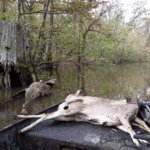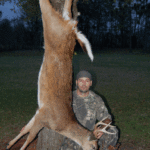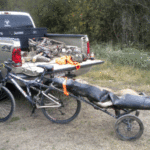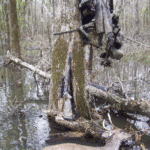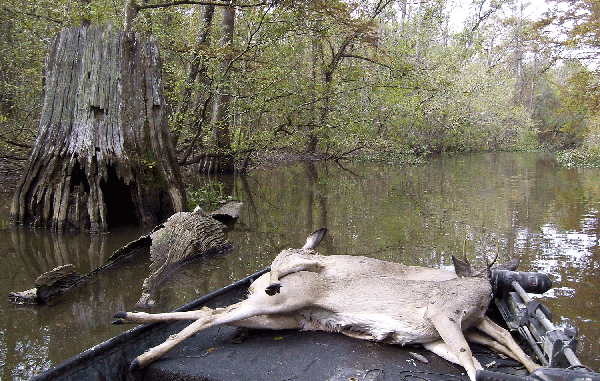
The Sherburne WMA complex offers great Thanksgiving hunting options. Here are some tips to making the most of this public-lands tradition.
The Friday after Thanksgiving 2011 found Lyle Savant of Central locating an active scrape near an oak flat deep within the interior of Sherburne Wildlife Management Area.
The Opelousas native, having scouted the area six weeks before this hunt, picked a tree adjacent to a thicket downwind of an oak where deer sign indicated heavy feeding.
Very early that morning, he heard a deer approaching at his back. He admittedly made the mistake of easing around and, unfortunately, the deer moved away.
“Then, just after daylight, here comes a deer chasing in almost a full run out of the thicket,” Savant said. “I saw two does, and I made the decision to take the last one since it was an either-sex day.”
As soon as the deer fell from his shot, Savant noticed it was actually a big spike.
“There were two does to my back, and I went ahead and dropped one of them,” Savant said.
It was just before 8 a.m., and the hunter descended from his high perch at 25 feet.
Hunting alone, he had had a great day after Thanksgiving. After all, he had killed two public-land deer, and seen four others.
And there was not another hunter around him for hundreds of yards.
Louisiana deer hunters have much to be thankful at Thanksgiving time — especially for Sherburne WMA, the Atchafalaya National Wildlife Refuge and the nearby Indian Bayou Area. These three areas offer nearly 72,500 acres of deer hunting on public lands in the swamps, sloughs, bottoms and wetlands of the central Atchafalaya Basin.
For the newcomer to these Louisiana public-land jewels, these areas are located in portions of Pointe Coupee, St. Martin, St. Landry and Iberville Parishes.
“The Sherburne either-sex hunts are popular for a number of reasons,” said Tony Vidrine, District VI biologist manager with the Louisiana Department of Wildlife & Fisheries. “First of all, it’s a long-standing tradition here that the days after Thanksgiving are available to deer hunters simply because it offers them holiday time with families and friends to hunt.
“Secondly, the deer are moving around engaging in pre-rut behaviors here in the Basin. Besides more daytime deer movement, hunters will see active scrapes, rubs and territorial behavior. Hunters will have more opportunities of harvesting deer because of these behaviors right before the peak rutting period occurs in December.”
Basin swamp deer tactics — a war of attrition
At 44 years of age, Savant is no newcomer at taking the swamp deer of the central Atchafalaya Basin. And he has taken many whitetails — somewhere over 50 — from both the Sherburne Complex and the Indian Bayou Area.
He will take deer by archery, firearms and primitive weapons, depending upon the season.
And as on during the 2011 Thanksgiving hunt, he has taken the two-deer limit at Sherburne on several occasions.
“Although I know the area very well, I still do most of my real scouting now by studying aerial topography and USGS maps,” he said. “I look for edge areas, funnels, thick areas, sloughs and swamps — and I will make waypoints on my computer using Garmin BaseCamp software and transfer these to my GPS.”
Over the years, Savant has figured out that to be successful at killing these swamp deer you have to get away from other hunters. And with 72,000 acres or so at his disposal, he has no problems negotiating these areas by bike, boat and boots (as well as waders).
When the season starts, Savant is a solo hunter who spends long hours in the woods.
“After the morning hunt, I’ll pack my Timbertall Baby Lite (stand) and slowly walk six- to seven- hours a day,” the hunter said. “I will walk, pause and walk repeatedly in this pattern, which I find mimics deer movement most of the time.
“I will also be looking for fresh scat (droppings) near heavily used feed trees — those with rubs in the area. And I’ll take the time and trouble to do what I have to do to get to those less-pressured areas.”
Savant refers to his efforts as a “war of attrition” for deer access — especially as the season progresses. The “attrition” he refers to is the fact that the Sherburne Complex receives much less hunting pressure as the season advances.
And when the pre-rut and prime rutting periods take hold during December and January, he is very vocal with deer calls.
“I have developed a system with calls,” Savant said explained. “I’ve rattled deer up to have them come through the thick stuff toward me. I’ve even used mock scrapes with success.
“I have taken deer with doe bleats early in the season, and I have also killed deer using tending grunts during the rut. I have been successful using the True Talker, the Primos Can and the Knight & Hale grunt call.
However, he attributes most of his success to simply getting to the deer and away from other hunters.
“For example, a friend wanted me to go hunt in an area where I knew there would be a lot of hunters during a muzzleloader hunt,” Savant said. “I politely declined, and we hunted separately.
“At midmorning he called to say he was disappointed in his hunt, relaying that he was seeing was nothing but hunter orange in his area. There were no deer even though there was plenty sign.
“He asked me how my hunt was, so I told him I hadn’t seen any hunters, yet I had shot seven times missing multiple does, but ended up scoring on a large cow-horn spike.
“This stark contrast not only proves but actually emphasizes the payoff for finding an isolated area with minimal hunting pressure.”
Certainly, Savant’s terms of “endeerment” with these public lands in the northcentral Atchafalaya Basin leaves him plenty to be thankful for.
